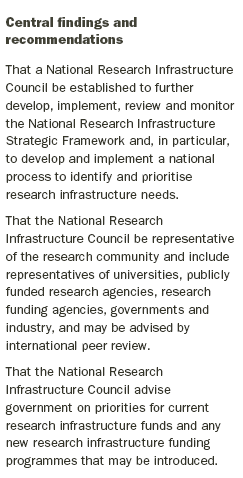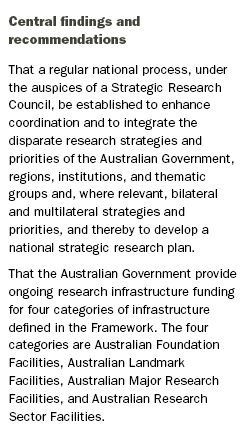|
Opinion- 31 March 2004 |
|
Australia's Research Infrastructure -- When Do We Want It? |
Aban Contractor, Sydney Morning Herald: Dr Nelson, can you give us a guarantee that the three Reports you listed there* haven't been edited to reflect Government priority...
Brendan Nelson, Minister for Education, Science and Training at March 24, 2004 Nation Press Club: Thanks. Firstly, ask [the three chairman] Professor Fell and Mr McGauchie and Mike Sargent in terms of the editing, you'll need to ask them. So I think they'd probably, well I won't on national television, I better be careful what I say, but I don't think they'd be impressed if there had been anything like that.
Hardly an illuminating answer, but probably one wasn't expected.
Of the three reports perhaps the one of most concern is The Final Report of the National Research Infrastructure Taskforce for two principal reasons:
the report, transmitted to the Minister barely three months after the Taskforce first called for submissions and began evaluation, made no serious attempt to assess the nation's research infrastructure, it could hardly have been otherwise, but rather called for the setting up of two new advisory councils to assist the Government in its future deliberations, and
another of the reports, Evaluation of Knowledge and Innovation Reforms Consultation Report, finds that the total cost of leveraging federal funding in 2003-04 from the Australian Research Council (excluding discovery grants), National Health and Medical Research Council, CRCs and Major National Research Facilities was about $450 million.
Dorothy Illing in the March 31, 2004 Australian quotes Australia's science Nobel Laureate, Peter Doherty as saying that universities in Australia were penalised for attracting high-quality researchers, a fundamental difference from the US system. There, a $1 million grant for five years would attract a 42 per cent payment - or $420,000 -- to the host institution for infrastructure support.
In addition the "External Reference Group" chaired by Professor Chris Fell found that the increased funds provided through Backing Australia's Ability is exacerbating the problem which in turn is furthering the universities inability to maintain their infrastructure let alone improve it – a matter that was considered to be of immediate concern over a decade ago. In an Op-Ed piece last September TFW wrote regarding the question of research infrastructure at the nation's universities only:
In 1992 the then Minister for Employment, Education and Training, Kim Beazley, requested the National Board of Employment, Education and Training to report on Higher Education Research Infrastructure. The Board invited the Boston Consulting Group to assist it in its determination, and in May1993 it forwarded its final report to the Minister.
The Board recommended an immediate increase above the then $342 million dollars provided by the Commonwealth for university research infrastructure of 37%, i.e. a total of $623 million, in current dollars would have been the recommendation for maintaining university research infrastructure of the 1995 university system, i.e. the year the changes were recommended to begin. The year the Coalition assumed government.
Remarkably, in the current submissions made to DEST in regard to Evaluation of the Knowledge and Innovation Reforms and the National Research Infrastructure Taskforce only six of the 194 sent even referred to the National Board of Employment, Education and Training and its work, and in those instances only cursorily.
It would seem that at the very least we might ask:
Was the recommended increase of $125 million per annum (1991 dollars) seen as the amount needed to prevent further erosion of the universities' research infrastructure? If not, what proportion would have been allocated for improvements beyond merely holding the line?
What were the effects of the Board's recommendations?
Allowing for increases in the demands for research and research training how would that $623 million (2002 dollars) translate to 2003 requirements?
Having moved on eight years since 1995 what in fact is the current Commonwealth support for university research infrastructure?
In hindsight did the Board and the Boston Consulting Group properly do the job they undertook for the Minister?
Eleven years have passed since the NBEET review and yet the current assessment directed by Dr. Nelson shows no sign of the thoroughness attempted in 1992-93.
Will even these basic questions receive answers?
An observer of the current manoeuvrings and the expenditure of millions of dollars on first one review and then another might be excused for concluding that the object was to avoid increasing governmental support for research in public institutions. Below are the two "Central findings and recommendations" of the Research Infrastructure Taskforce.
It would seem inadvisable for the research community to hold its breath in anticipation of critical support while the top half of the OECD nations moves ever further ahead of us.
 |
 |
Alex Reisner
The Funneled Web
*National Research Infrastructure Taskforce![]() (3.2Mb),
(3.2Mb),
Evaluation of the Knowledge and Innovation Reforms
Reviewing Australia’s Block Research Funding Schemes![]() (3.3Mb),
(3.3Mb),
Review of
Closer Collaboration Between Universities and Major Publicly Funded Research
Agencies![]() (1.9Mb)]
(1.9Mb)]